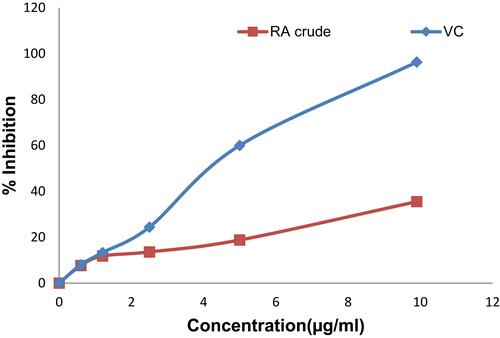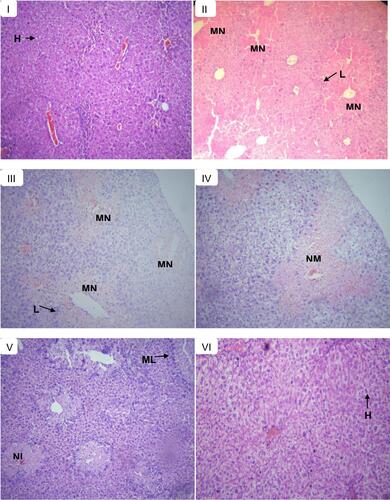Figures & data
Table 1 IC50 Values of DPPH Radical Scavenging Activity of the Solvent Fractions of Rumex abyssinicus in Comparison with Vitamin C
Figure 1 DPPH radical scavenging activity of different concentrations of dried rhizomes of R. abyssinicus crude extract (RA-crude) and vitamin C (VC).

Figure 2 DPPH radical scavenging activity of different concentrations of solvent fractions: petroleum ether (PE), chloroform (CHCl3), ethyl acetate (EtOAc), butanol (BtOH), and aqueous (H2O) fractions from R. abyssinicus extract.

Table 2 Effects of Different Concentrations of R. abyssinicus Crude Extract and Silymarin on Serum Biochemical Parameters
Figure 3 Histopathological section of liver tissues in control and experimental groups of mice in the pre-treatment model; showing normal hepatic cells (H), lymphocytic infiltrates (L), multifocal necrosis (MN), moderate necrosis (NM), mild lymphocytic infiltrates (ML), and mild necrosis (NL). (A) Normal control received with distilled water, (B) toxic control received CCl4, (C) treated with 125 mg/kg extract, (D) treated with 250 mg/kg extract, (E) treated with 500 mg/kg extract, and (F) treated with silymarin 100 mg/kg.

Table 3 Effect of the 80% Methanolic Extract and Butanol Fraction Obtained from the Dried Rhizomes of R. abyssinicus and Silymarin Against CCl4-Induced Hepatotoxicity on Serum Biochemical Parameters
Figure 4 Histopathological section of liver tissues in control and experimental groups of mice in the post-treatment model; showing normal hepatic cells (H), lymphocytic infiltrates (L), mild lymphocytic infiltrates (ML), mild necrosis (NL), and extensive necrosis (EN). (A) Normal control received with distilled water, (B) toxic control received CCl4, (C) treated with 500 mg/kg extract, (D) treated with 500 mg/kg butanol fraction, and (E) treated with silymarin 100 mg/kg.

